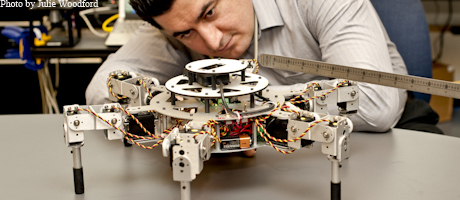By Jennifer Eder
Imagine sharing a cubicle, going to an office meeting or attending a conference with a robot.
That's what GW engineering professor Pinhas Ben-Tzvi predicts will happen in just a few decades.
“The use of robotics has become revolutionary,” says Dr. Ben-Tzvi, director of GW’s Robotics and Mechatronics Lab in the School of Engineering and Applied Sciences. “About 20 years ago, robots were used only in industrial settings. They were slow moving stationary systems that did pre-determined tasks. But in the last decade, robots have begun entering the real world.”
In a way, Dr. Ben-Tzvi, a professor in the Department of Mechanical and Aerospace Engineering, is already helping to make robot co-workers a reality.
Thanks to a $300,000 grant from the Defense Advanced Research Projects Agency – an agency within the Department of Defense responsible for developing new technology for the U.S. military – Dr. Ben-Tzvi is creating mobile robots that can be used for military and police operations as well as for search and rescue purposes.
“The robots I’m developing are similar to what you’ve seen in the movie, ‘The Hurt Locker,’” says Dr. Ben-Tzvi. In “The Hurt Locker,” which won the Academy Award for best picture earlier this year, a U.S. Army bomb squad uses a robot to help dismantle bombs.
“Our work will lay the foundation for research developments around military and civilian robots,” says Paul Moubarak, a doctoral student studying mechanical engineering.
Robots are typically designed to either move somewhere or manipulate something by grasping or carrying it. But Dr. Ben-Tzvi has created a hybrid system that not only combines the locomotion and manipulation functions but has increased both the strength and resiliency of the robot.
“Hybrid mobile robots are sharing the functionalities symbiotically, and they’re not as susceptible to breaking,” he says. “Because robots are required to do more difficult tasks, such as removing debris, opening doors, searching for victims and dismantling bombs, they need greater functionality.”
Under the DARPA grant, Dr. Ben-Tzvi is now working on a new mobile robot design with the capability of operating autonomously rather than through wireless remote control.
“This is extremely difficult to do because the infrastructure necessary for autonomy requires much greater computing capacity and speed, new sensing capabilities and complex decision making,” he says. “Very few mobile robots can do this right now.”
By working autonomously, the robots will use sensors, for example, to determine if something is in fact a bomb.
“It’s very exciting research,” says Zhou Ma, a doctoral student studying mechanical engineering who’s working alongside Dr. Ben-Tzvi. “These robots will be able to do things that are too risky for humans.”
Dr. Ben-Tzvi’s team has to turn in their design to DARPA at the end of the year, and Dr. Ben-Tzvi hopes U.S. military units and police departments will use it for monitoring, inspection and surveillance.
“There are only a few ways of improving things,” says Dr. Ben-Tzvi. “There is either evolutionary improvement or revolutionary improvement. I like revolutionary improvement.”


